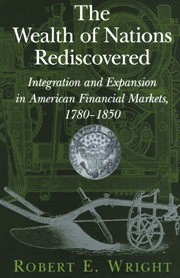 The Wealth of Nations Rediscovered
The Wealth of Nations Rediscovered Book contents
- Frontmatter
- Contents
- List of Tables
- Acknowledgments
- List of Abbreviations
- The Wealth of Nations Rediscovered
- 1 Introduction: The Wealth of Nations and National Wealth
- 2 The International and Colonial Background of America's Financial Revolution
- 3 Banks, Securities Markets, and the Reduction of Asymmetric Information
- 4 The Financial Sector and the Reduction of Lending-Related Costs and Risks
- 5 Evidence of Capital Market Integration, 1800–1850
- 6 Expansion of the Securities Services Sector, 1790–1850
- 7 The Freest of the Free: Regulation of the Financial Sector
- 8 Finance-Directed Economic Development
- 9 Conclusion
- References
- Index
8 - Finance-Directed Economic Development
Published online by Cambridge University Press: 16 January 2010
- Frontmatter
- Contents
- List of Tables
- Acknowledgments
- List of Abbreviations
- The Wealth of Nations Rediscovered
- 1 Introduction: The Wealth of Nations and National Wealth
- 2 The International and Colonial Background of America's Financial Revolution
- 3 Banks, Securities Markets, and the Reduction of Asymmetric Information
- 4 The Financial Sector and the Reduction of Lending-Related Costs and Risks
- 5 Evidence of Capital Market Integration, 1800–1850
- 6 Expansion of the Securities Services Sector, 1790–1850
- 7 The Freest of the Free: Regulation of the Financial Sector
- 8 Finance-Directed Economic Development
- 9 Conclusion
- References
- Index
Summary
Thomas Willing, Michael Hillegas, Alexander Bryan Johnson, Eleazar Lord, and scores of other early U.S. financial pioneers understood that none of the major means of economic growth hitherto explored by economic historians could have flourished without modern capital markets. The great triad of the early U.S. economy – trade, agriculture, and manufacturing – all relied on the financial sector. Indeed, one is hard pressed to find a single major economic activity or innovation that did not receive crucial support from banks, other types of financial intermediaries, or securities markets. The root cause of early U.S. economic growth (1780–1850), therefore, is the development of the financial sector, not transportation and communication improvements, not foreign trade, and not manufacturing firms.
Banks supplied short-term liquidity credit to merchants and traders, corporate transportation companies, and manufacturing concerns of all types. Banks, especially local, country banks, lent directly to farmers. The agricultural sector gained most, however, from banks' loans to merchants and transportation companies. The merchants paid farmers with cash; by decreasing transportation costs, the internal-improvement companies increased the demand for farmers' products, “expanding the market” in Smithian terms.
Securities markets were also of prime importance. The sale of corporate equities and bonds or the sale of state bonds financed internal improvements. Increasingly, manufacturing firms assumed corporate form in order to tap long-term investment funds. Merchants rarely incorporated into trading companies, but they used the securities markets much as banks did, to keep relatively safe, liquid, interest-bearing assets on their balance sheets.
- Type
- Chapter
- Information
- The Wealth of Nations RediscoveredIntegration and Expansion in American Financial Markets, 1780–1850, pp. 193 - 211Publisher: Cambridge University PressPrint publication year: 2002


